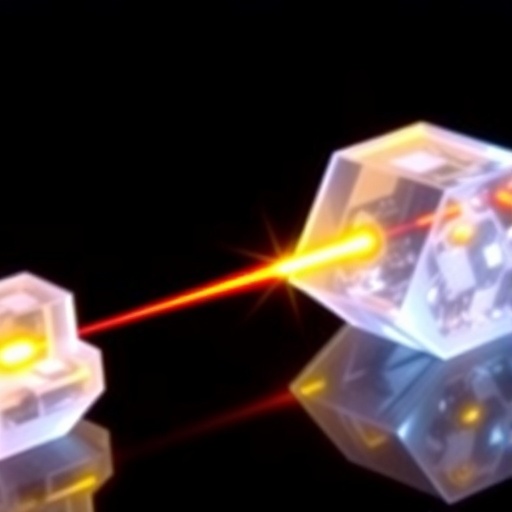The Future of Quantum Devices Shaped by Strontium Titanate Crystals
In a groundbreaking study published in the journal Science, researchers have unveiled the extraordinary properties of strontium titanate (SrTiO3) crystals, which have the potential to revolutionize the field of quantum computing and optoelectronics. The ongoing quest to develop advanced quantum devices hinges on materials that can manipulate light with incredible precision, and SrTiO3 has demonstrated capabilities far superior to its contemporaries. This crystalline material holds the key to enhancing the functionality of quantum systems, making it a pivotal development in the realm of modern physics and engineering.
At the very core of this research lies the principle of light manipulation at low temperatures, a necessity for quantum devices. The unique properties of strontium titanate allow electric fields to sculpt light fields with exceptional effectiveness, showing performance improvements by orders of magnitude compared to conventional materials. As scientists delve deeper into the behavior of these crystals, they uncover insights that could lead to substantial advancements in photonics and quantum information systems.
Research indicates that strontium titanate possesses what is known as a quantum critical point: a transition at which the material’s properties change drastically due to quantum fluctuations. This critical point is crucial for understanding how the material can affect the electro-optic and piezoelectric nonlinearities essential for quantum applications. By analyzing the interactions between the material’s structural, electronic, and optical properties, researchers have developed a more profound comprehension of how to engineer devices that rely on its capabilities.
This study emphasizes the crucial role of low temperatures in harnessing the unique properties of strontium titanate. In quantum devices, operating at such temperatures can cause various physical phenomena to emerge, leading to new behaviors in electronic states. The researchers have highlighted how the manipulation of light fields through electric fields can be fine-tuned, offering unprecedented levels of control in quantum systems.
One of the most exciting outcomes of this research is the potential application of strontium titanate in the field of quantum computing. The development of qubits, or quantum bits, relies heavily on the materials employed to create and manipulate them. With the findings surrounding strontium titanate, scientists believe that they can enhance the coherence times and fidelity of qubits, which are critical for testing and implementing quantum algorithms in real-world scenarios.
Moreover, the study has implications beyond quantum computing. The intricate interplay between electro-optic and piezoelectric effects in strontium titanate could also pave the way for the development of advanced sensors and actuators. These features hold the promise of significant improvements in various technologies, including telecommunications and advanced imaging systems.
The investigation into strontium titanate further elucidates the mechanisms underlying the generation of non-linear optical responses. Understanding how these optical responses interact with quantum states enables researchers to develop new types of light sources and detectors, integral for advancing optical communication networks. As societies increasingly rely on these technologies, improvements derived from strontium titanate could lead to more efficient and powerful communication methods.
As the research progresses, the scientists involved are keen to enhance existing knowledge on how to manipulate light matter interactions at the quantum level. Unraveling the complexities of strontium titanate opens the door to a new paradigm in the design of materials that can be tailored for specific quantum applications, thus providing a solid foundation for future theoretical and experimental work in this expanding field.
While the findings are still in their infancy, the implications of this research suggest that the future of quantum technologies may shift dramatically with the incorporation of strontium titanate. With a heightened understanding of material properties and their quantum behavior, the focus can now shift to experimental implementations. Scientists will likely work on integrating this material into next-generation quantum devices that require high levels of precision in light manipulation.
The excitement surrounding the potential use of strontium titanate also raises anticipation for further studies that validate and expand upon these initial findings. Conducting experiments to develop practical applications using srontium titanate in real-world quantum systems could lead to innovations once thought unattainable.
In conclusion, strontium titanate crystals serve as a fundamental breakthrough in the field of quantum optics and computing. Researchers are just beginning to tap into this material’s immense potential that could significantly impact the evolution of quantum technologies. As this line of inquiry progresses, it promises to yield transformative approaches to harnessing the power of quantum mechanics for diverse applications.
Subject of Research: Strontium Titanate Crystals in Quantum Devices
Article Title: Quantum critical electro-optic and piezo-electric nonlinearities
News Publication Date: 23-Oct-2025
Web References: DOI: 10.1126/science.adx865
References: None provided
Image Credits: Second Bay Studios
Keywords: Physical sciences, Materials science, Applied sciences and engineering, Applied mathematics, Computational science, Quantum computing.




